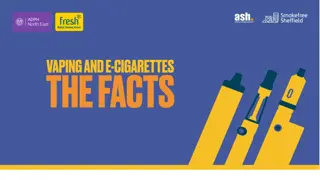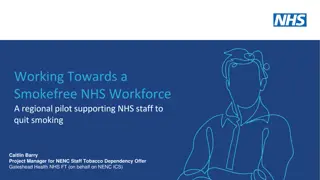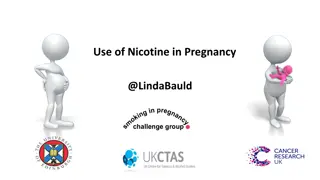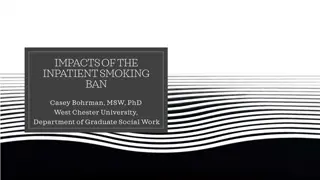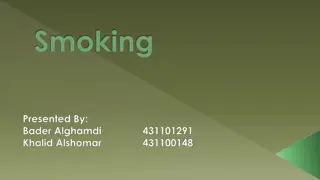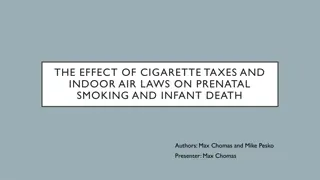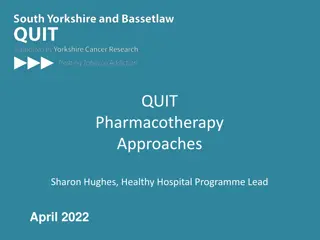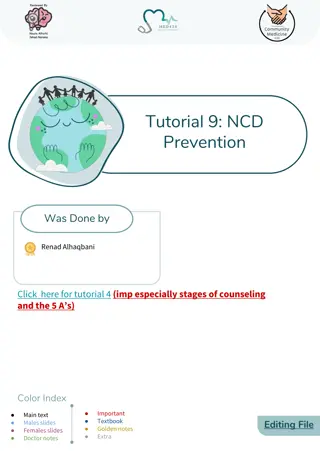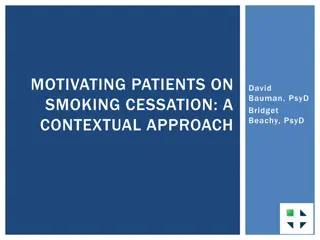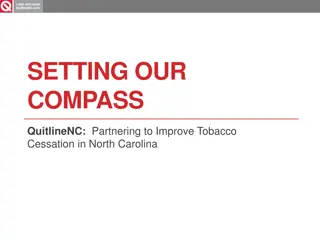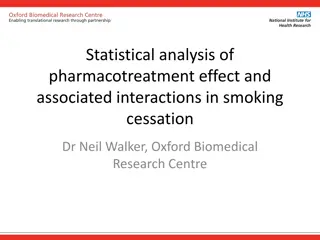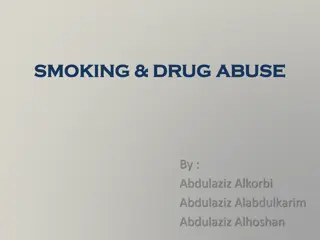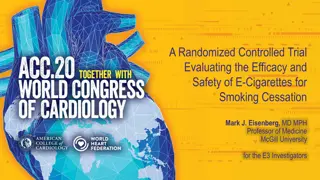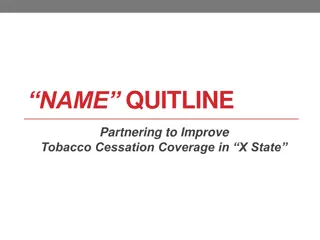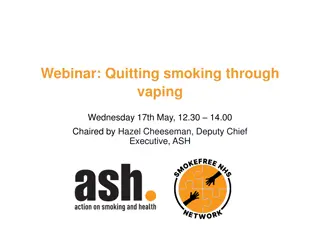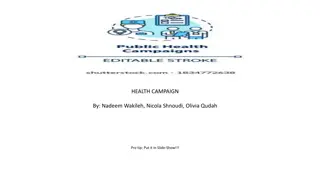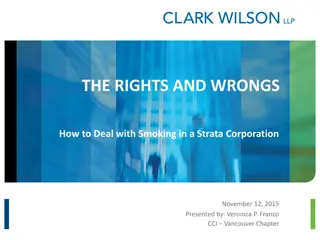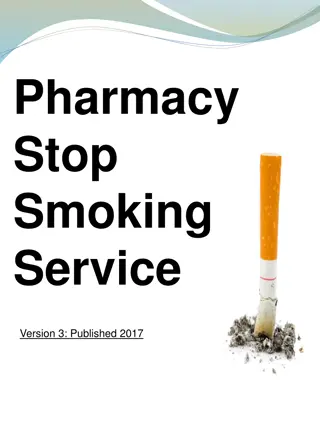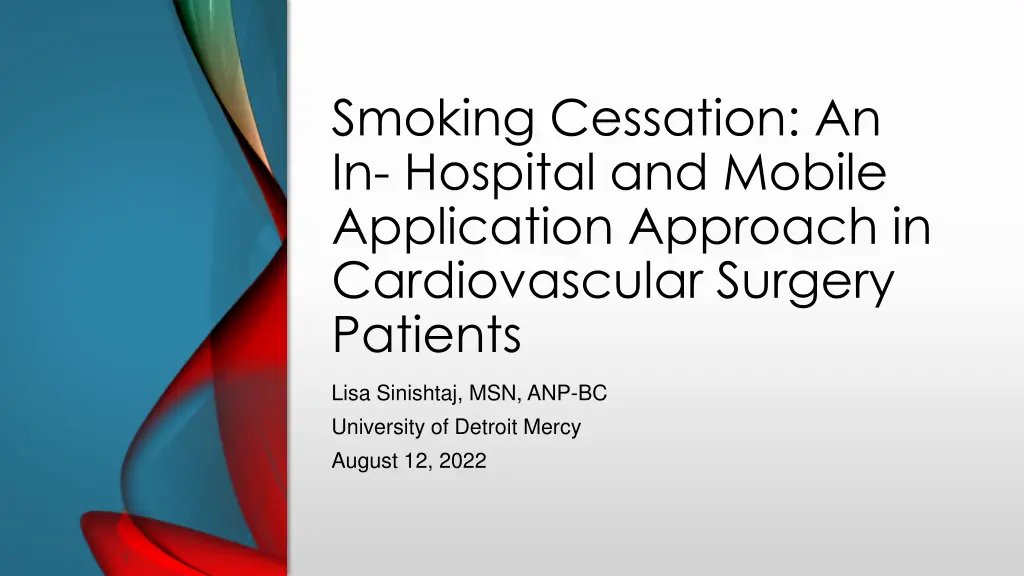
Effective Smoking Cessation in Cardiovascular Surgery Patients
Explore a comprehensive approach to smoking cessation in cardiovascular surgery patients, highlighting the impact of smoking on heart disease, benefits of quitting, and importance of tailored interventions. Discover the significance of behavioral support and evidence-backed strategies to enhance patient outcomes.
Uploaded on | 2 Views
Download Presentation

Please find below an Image/Link to download the presentation.
The content on the website is provided AS IS for your information and personal use only. It may not be sold, licensed, or shared on other websites without obtaining consent from the author. If you encounter any issues during the download, it is possible that the publisher has removed the file from their server.
You are allowed to download the files provided on this website for personal or commercial use, subject to the condition that they are used lawfully. All files are the property of their respective owners.
The content on the website is provided AS IS for your information and personal use only. It may not be sold, licensed, or shared on other websites without obtaining consent from the author.
E N D
Presentation Transcript
Smoking Cessation: An In- Hospital and Mobile Application Approach in Cardiovascular Surgery Patients Lisa Sinishtaj, MSN, ANP-BC University of Detroit Mercy August 12, 2022
According to the Center for Disease Control and Prevention (CDC, 2019), heart disease is the leading cause of death (approximately 655,000 /year or 1:5 deaths) in adults Between smokers & non-smokers (Sadiya, 2021): smokers had increased risk for heart disease (46% vs 35%), earlier presentation of heart disease by 5 years, and heart failure (12% vs 5%) INTRODUCTION Nationally, the rate of cigarette use in adults is 17% and in the state of Michigan it is 20% Patients with heart disease are most receptive to smoking cessation interventions following an acute cardiac event
BACKGROUND Cigarette smoking increases the cardiovascular death rate by 14% and the risk for recurrent myocardial events. Just smoking 20 cigarettes / per day increases heart disease. Cost for healthcare is shown to be higher for current smokers vs former smokers. Healthcare savings: approx. $1327.53 / year after smoking cessation for 0-4 years. Despite knowing this, smoking continues to be a modifiable risk factor in cardiovascular patients, and we must continue to reassess what we do in healthcare so we can assist this population as they work in smoking cessation. (Baker et al., 2018, CDC, 2019, Rana&Go, 2015, Tolstrup et al., 2014,)
BEAUMONT TROY: SMOKING CESSATION PROGRAM Out-patient six-week program that was delivered through the cardiac rehab program taught by respiratory therapist staff one month after discharge This is a voluntary program Meet once per week for 90 minutes and focus on smoking risks, health effects, dependence, and benefits of quitting Follow up at one-month, six-months, and 1-year Participants can come back cost-free if they relapse Due to COVID-19, the smoking cessation program was suspended with no current plans to open this year No formal in-hospital or outpatient smoking cessation process implemented since their closure
We know that smoking increases complications including inflammation and infections. Significant findings show that smoking cessation can reduce recurrent myocardial infarctions by as much as 50% and have a life expectancy gain of 3 years for patients that undergo CABG. The most pertinent finding that could benefit this population is that smoking cessation could improve patency of their bypasses. SIGNIFICANCE Providing patients with behavioral support that starts during hospitalization can improve smoking cessation rates. (Boston University, 2018, Rice et al., 2017, Schmid et al., 2015, Snaterse et al., 2015) Smoking trends in CV surgery (Troy Beaumont): 2019: 11% 2020 (Jan June): 16%
PROBLEM STATEMENT At Troy Beaumont smoking cessation during hospitalization mostly consists of staff telling them You should quit smoking . The smoking cessation program that is offered to patients through cardiac rehab has been closed during COVID without any process to support patients. Despite this , there are many opportunities for smokers to get assistance with quitting, including smart phone applications, group settings, phone assistance, and online information but some patients are unaware on their options and how to access the information.
1. Does an in hospital smoking cessation program with individualized teaching, integrating an innovative smoking cessation mobile application and assessment at three days post-discharge improve smoking cessation rates for cardiovascular surgery patients? CLINICAL QUESTIONS 2. How do the participants rate their satisfaction with the QuitGuide smoking cessation application?
LITERATURE REVIEW OUT-PATIENT COUNSELING HOSPITAL INTERVENTION Snaterse et al. (2015) Support should continue after discharge since majority of patients go back to smoking within 8 weeks.. Nahmias et al. (2016) implemented program for trauma and decrease rates by 3%. Studies have shown importance of continued support post discharge. Patients with mid-low intention benefited the most from personal interventions but the pandemic forced us to utilize innovative measures to provide personalize support. Studies also have shown to reduce mortality rates, improve smoking cessation rates
LITERATURE REVIEW SELF-EFFICACY MOBILE SUPPORT De Hoog et al, (2016) intention to quit, making action, and coping plans influenced continued abstinence from smoking mobile apps provide information & support to those with support barriers. 60% of smokers use a smoking cessation app to assist in smoking cessation when given a choice and may be best used in smokers who have a mod- high intention to quit. (Chevalking et al., 2018, Eysenbach, G., 2018) strong determinant of success with behavioral change,
SETTING/SAMPLE William Beaumont Hospital located in Troy, MI. It is a 530- license bed hospital whose mission and vision statement are to provide compassionate, extraordinary care every day and be the leading high-value health care network focused on extraordinary outcomes through education, innovation and compassion (Beaumont Hospital, 2020) ORGANIZATIONAL ASSESSMENT The unit that this project will be initiated is the Cardiac Progressive Care Unit (CPCU) . Unit is cardiac based, and the nurses are BSN prepared Inclusion criteria: ages of 18-64 years, speak English, and own a smartphone with internet access, underwent Cardiac surgery Exclusion criteria: <18 or >64, non English speaking, does not own a smart device with internet access, refuses to participate, or has some form of a mental disability.
SWOT ANALYSIS STRENGTHS Surgeon / unit staff support 2019 Community Health Needs Assessment as smoking cessation a priority WEAKNESS Limited options to patients due to closure of smoking cessation clinic No formal process in support of smoking cessation OPPORTUNITIES THREATS Tracked by BCBS / State Michigan of Thoracic & Cardiovascular Surgeons with possible reimbursement Decrease in nursing & APP staffing Time constraints Covid
THEORETICAL FRAMEWORK Bandura s Social Cognitive Theory The premise of this theory is if we empower patients with resources that would influence their self-efficacy and provide them the means to improve their health including in succeeding in smoking cessation. Transtheoretical Model of Change (TTM)- Prochaska Stages of Change Determining their readiness in order to provide the most appropriate intervention / teaching.
The purpose of this pilot project is 1. to determine if individualized in-hospital smoking cessation teaching and smoking cessation mobile application improves smoking cessation rates at 1 month after discharge PURPOSE STATEMENT 2. evaluate patient satisfaction ratings related to the use of the smoking cessation mobile application within this population
1. Implement an in-hospital smoking cessation teaching program for cardiac patients undergoing surgery during their admission. 2. Assist to develop a trigger/coping plan for patients before discharge. 3. Sign up for a smoking cessation mobile application before discharge 4. Improve smoking cessation rates at 1month after discharge. GOALS AND OBJECTIVES
PROJECT DESIGN Quality Improvement The timeline of the project was approximately six months. The timeframe was increased due to COVID restrictions
METHODOLOGY INTERVENTION Time frame for this project was October 2021 to March 2022 Smoking cessation status is assessed at the time of admission of a cardiac event or surgery Patient met on transfer to CPCU and verbal consent obtained to be admitted to the project Questionnaires completed: Demographics, The Smoking Abstinence Self-efficacy Questionnaire (SASEQ), Motivation to Stop Scale (MTSS) Information on Smokefree.gov website provided and sign up for Quitguide smoking cessation mobile application Assist in developing a trigger/coping plan for smoking cessation to follow on discharge The RN that was part of the project provided re-inforcement on the obove two steps At the end of one month, patient s smoking status was assessed, and the action/coping plan and smoking cessation application rating were reviewed.
METHODOLOGY Measures / Tools 1. Interview / Demographic form Determine smoking status. determine the action/coping plan The follow up interview was done as a Face to face appointment three days after discharge which coincided with their surgery follow up appointment. 2. The smoking abstinence self-efficacy questionnaire (SASEQ). assesses self-efficacy by asking questions related to social and emotional situations. The higher the score then the higher self-efficacy. Speck et al. (2013) utilized this questionnaire and stated that it was found to be reliable and valid in predicting smoking cessation success. 3. Motivation to stop scale (MTSS). assesses patient s motivation by determining their intention, desire, and belief to quit smoking Hummel et al. (2017) found this questionnaire to be a reliable tool to predict quit attempts with patients who scored high.
METHODOLOGY QUITGUIDE MOBILE APPLICATION 24/7 support with a Smokefree app for your smartphone. helps you understand your smoking patterns and build the skills needed to become and stay smokefree. Tracks how many days smokefree and how much money saved during that time Provides information on developing a plan, management of triggers, withdrawal symptoms, tips if you slip, and steps to remain smokefree Sign up for support notifications during specific times / locations you need added support 1800 number to call if you want to speak with someone Text option if you want text support SMOKERSFREE.gov website also provides added information / support
The Smoking Abstinence Self-efficacy Questionnaire (SASEQ) You feel agitated or tense. Are you confident that you will not smoke? Certainly. Probably. Neutral / don t know Probably not. Certainly not You are (very) angry. Are you confident that you will not smoke? Certainly. Probably Neutral/don t know Probably not Certainly not You are in a cafe , at a party, or paying a visit. Are you confident that you will not smoke? Certainly. Probably. Neutral/don t know Probably not. Certainly not You feel (very) sad. Are you confident that you will not smoke? Certainly. Probably. Neutral/don t know Probably not. Certainly not Someone offers you a cigarette of your own brand. Are you confident that you will not smoke? Certainly Probably. Neutral/don t know Probably not. Certainly not You see someone enjoy smoking. Are you confident that you will not smoke? Certainly. Probably. Neutral/don t know Probably not. Certainly not The scores for the subsequent responses are the following: Certainly=4. Probably=3. Spek, V., Lemmens, F., Chatrou, M. (2013). Development of a Smoking Abstinence Self-efficacy Questionnaire. Int.J. Behav. Med. Neutral/don t know=2. Probably not=1. Certainly not=0
Motivation to Stop Scale (MTSS) Which of the following describes you 1. I don t want to stop smoking 2. I think I should stop smoking but don t really want to 3. I want to stop smoking but haven t thought about when 4. I REALLY want to stop smoking but I don t know when I will 5. I want to stop smoking and hope to soon 6. I REALLY want to stop smoking and intend to in the next 3 months 7. I REALLY want to stop smoking and intend to in the next month ordering reflects: (i) absence of any belief, desire or intention, (ii) belief only, (iii) moderate desire but no intention, (iv) strong desire but no intention, (v) moderate desire and intention, (vi) strong desire and medium- term intention and (vii) strong desire and short-term intention. Hummel, Karin, Brown, Jamie, Willemsen, Marc C, West, Robert, & Kotz, Daniel. (2017). External validation of the Motivation To Stop Scale (MTSS): Findings from the International Tobacco Control (ITC) Netherlands Survey. European Journal of Public Health, 27(1), Kotz D, Brown J, West R. Predictive Validity of the Motivation to Stop Scale (MTSS): A single-item measure of motivation to stop smoking. Drug and alcohol dependence. 2013;128(1-2): 15-9.
METHODOLOGY Cost Minimal cost of the project was provided by the project manager Office supplies Time invested in this project correlated with existing responsibilities with my role as a CV surgery APP Ethical Consideration Participant confidentiality was ensured using participant identification numbers and individual folders to maintain personal information. Only the project manager had access to the information. IRB approval through William Beaumont Hospital and the University of Detroit Mercy
ANALYSIS PLAN Question Measures Analytic 1. Does an in hospital smoking cessation program with individualized teaching, trigger / coping plan and assessment at three days post-discharge improve smoking cessation rates at one month? I: individualized in hospital teaching Descriptive D: smoking cessation rates 2. Participants satisfaction rating of QuitGuide smoking cessation mobile application? I: smoking cessation mobile application Descriptive D: satisfaction rating of application
DATA ANALYSIS DEMOGRAPHICS Recruitment Assessment Eligible Participants 93 patients 71 males (76%), 22 females (24%) 49 patients non-smokers Mean age 66 35 patients former smokers (38%) Mean age 67 9 patients smokers (10%) Mean age 65 9 patient smokers 7 males (7%) 2 females (2%) 2 patients refused to participate 3 did not meet inclusion criteria 1 surgery aborted 3 patients consented to participate 2 males, 1 female Mean age 60 years
DATA ANALYSIS -- RESULTS 3 patients enrolled in the project Mean duration of smoking for participants was 32 years of smoking All smoke free at follow up visit on day 3 and 1 month after discharge Mean satisfaction rate of smoking cessation mobile application for males 2.5/5 Their satisfaction revolved on how much money they saved during this time / length of their smoking cessation Mean satisfaction rate of smoking cessation mobile application for female 5/5 Support she received with the text messages No significant differences in the participants due to low number of participants.
DATA ANALYSIS Variable SEX MALE FEMALE n % 2 1 66.667 33.333 3 day MALE One month 3 day One month FEMALE Variable APPLICATI ON_RATE SMOKING_STAT US_1_MONTH_ YES 0 (0.00%) NOT SATISFIED 0 (0.00%) 0 (0.00%) 0 (0.00%) 3 100.000 0 (0.00%) SLIGHTLY SATISFIED 0 (0.00%) 1 (50.00%) 0 (0.00%) Two-Tailed Mann-Whitney Test for APPLICATION_RATE_ 0 (0.00%) NEUTRAL 1 (50.00%) 0 (0.00%) 1 ( 50%) SOMEW HAT SATISFIED Mean Rank 0 (0.00%) 0 (0.00%) 0 (0.00%) 1 (50%) Variable MALE FEMALE U z p APPLICATI ON_RATE_ Ordinal 1.50 3.00 0.00 -0.43 .667 VERY SATISFIED 0 (0.00%) 1 (100.00%) 0 (0.00%) 1 (100%) Total 2 (100.00%) 1 (100.00%)
Limitations COVID-19 and decrease in surgeries Exclusion criteria of age because it limited the amount of patients recruited for this project Based on the literature, relapse is up to 8 weeks and evaluation was done at one month after discharge. Recommendations for future projects implement project in a different patient population consider a mixed-methods design to include a qualitative component which would provide rich insight to motivation and program satisfaction assess if smoking cessation mobile application improved self-efficacy and sustained motivation Re-assessing smoking cessation for a total 8 weeks project to randomizing participants between in- hospital teaching vs in-hospital teaching w/smoking cessation application only to assess any significant benefit for smoking cessation mobile application LIMITATIONS / RECOMMENDATIONS
IMPLICATIONS TO PRACTICE Tracked by BCBS / State Michigan of Thoracic & Cardiovascular Surgeons with possible reimbursement incentives. Reimbursement is provided to institutions with an actual plan on smoking cessation provided to these patients. Instituting innovative tools and practices to promote sustainable smoking cessation from in-patient to home environment Changed unit practice to include patient teaching regarding smoking cessation transitioning to an outpatient program setting Institute practice to include other patient populations on unit
Present findings to CPCU unit manager and CV surgeon along with the information that the smoking cessation program will not be resumed at this time. Present the findings to other Beaumont hospitals to provide them with the information regarding the tools and make it available to their patients DISSEMINATION OF PROJECT The information / tools that will be provided to CV surgery patients will also be provided to the rest of the cardiac patients who are current smokers. Speaking with Magnet program manager to include the project to their Magnet research table Explore opportunities for poster presentation to present at MICNP
1. Karen Mihelich DNP, ACNS-BC, CDCES ACKNOWLEDGEMENTS 2. Colleen Joseph & Sara Zarr 3. My Family
REFERENCES Baker, Christine L. JD, MPH; Bruno, Marianna PharmD, MPH; Emir, Birol PhD; Li, Vicky W. MPH; Goren, Amir PhD. (2018). Smoking Cessation Is Associated With Lower Indirect Costs. Journal of Occupational and Environmental Medicine. Berndt, De Vries, Lechner, Van Acker, Froelicher, Verheugt, Mudde, and Bolman. (2017). "High Intensity Smoking Cessation Interventions: Cardiac Patients of Low Socioeconomic Status and Low Intention to Quit Profit Most." Netherlands Heart Journal: Monthly Journal of the Netherlands Society of Cardiology and the Netherlands Heart Foundation 25.1 Bucholz, Emily M, Adam L Beckman, Catarina I Kiefe, and Harlan M Krumholz. (2017). "Life Years Gained From Smoking-Cessation Counseling After Myocardial Infarction." American Journal of Preventive Medicine 52.1 Butts, J.B., & Rich, K.L. (2018). Philosophies and Theories for Advanced Nursing Practice.3rd Carnethon, M. R., Pu, J., Howard, G., Albert, M. A., Anderson, C., Bertoni, A. G., Mujahid, M. S., Palaniappan, L., Taylor, H. A., Jr, Willis, M., Yancy, C. W. (2017). Cardiovascular Health in African Americans: A Scientific Statement From the American Heart Association. Circulation, 136(21), e393 e423. Cartmell KB, Dismuke CE, Dooley M, Mueller M, Nahhas GJ, Warren GW, Fallis P, Cummings KM. (2018). Effect of an Evidence-based Inpatient Tobacco Dependence Treatment Service on 1-Year Post-discharge Health Care Costs. Med Care. Center for Disease Control and Prevention. (2020). Smoking and Heart disease. Retrieved from https://www.cdc.gov/heartdisease/facts.htm
REFERENCES Chevalking, S., Allouch, S., Brusse-Keizer, M., Postel, M., & Pieterse, M. (2018). Identification of Users for a Smoking Cessation Mobile App: Quantitative Study. Journal of Medical Internet Research, 20(4), E118. De Hoog, N., Bolman, C., Berndt, N., Kers, E., Mudde, A., De Vries, H., & Lechner, L. (2016). Smoking cessation in cardiac patients: The influence of action plans, coping plans and self-efficacy on quitting smoking. Health Education Research, 31(3) Eysenbach, G., Tome-Pires, C., Styn, M., Chavannes, N., Granado-Font, E., Ferr -Grau, C., Flores-Mateo, G. (2018). Coping Strategies and Social Support in a Mobile Phone Chat App Designed to Support Smoking Cessation: Qualitative Analysis. JMIR MHealth and UHealth, 6(12) Flott, E. A. (2015). Smoking Cessation Strategies for Patients with COPD. Home Healthcare Now, 33(7) Gennaro, Giustino, Sorin J Brener, Bj rn Redfors, Ajay J Kirtane, Philippe G n reux, Akiko Maehara, Thomas Neunteufl, D. Christopher Metzger, Roxana Mehran, C. Michael Gibson, and Gregg W Stone. (2016). "Effect of Smoking on Infarct Size and Major Adverse Cardiac Events in Patients With Large Anterior ST-Elevation Myocardial Infarction (from the INFUSE-AMI Trial)." The American Journal of Cardiology118.8 1097-104. Grandi, S., Eisenberg, M., Joseph, L., O'Loughlin, J., Paradis, G., & Filion, K. (2016). Cessation treatment adherence and smoking abstinence in patients after acute myocardial infarction. American Heart Journal, 173 Hammal, F., Ezekowitz, J. A., Norris, C. M., Wild, T. C., Finegan, B. A., & APPROACH Investigators (2014). Smoking status and survival: impact on mortality of continuing to smoke one year after the angiographic diagnosis of coronary artery disease, a prospective cohort study. BMC cardiovascular Lee, D., Lee, Y. & Oh, I. (2019). Cost-effectiveness of smoking cessation programs for hospitalized patients: a systematic review. Eur J Health Econ 20, 1409 1424 https://doi.org/10.1007/s10198-019-01105-7 Lindsay, G & Tolmie, Elizabeth & Martin, W & Hutton, I & Belcher, Philip. (2009). Smoking after Coronary Artery Bypass: High Three-Year Mortality. The Thoracic and Cardiovascular Surgeon. 57. 135-40. 10.1055/s-2008-1039271. Mushtaq, N.PhD. & Beebe, L. Phd. (2017). Psychometric Properties of Fagerstrom Test for Nicotine Dependence for Smokeless Tobacco Users (FTND-ST). Nicotine & Tobacco Research. 19 (9). Nahmias, J., Doben, A., Poola, S., Korntner, S., Carrens, K., & Gross, R. (2016). Implementation of a quality improvement project on smoking cessation reduces smoking in a high risk trauma patient population. World Journal of Emergency Surgery, 11(15), 15 Patlolla, Harish, Khosla, Sandeep, & Parmar, Sneha. (2017). Effect of Hospital Intervention on Smoking Cessation 30 Days after Admission for Acute Coronary Syndrome. JACC (Journal of the American College of Cardiology), 69(11), 53.
REFERENCES Rana, Jamal S., and Go, Alan S. (2015). National Burden of Cardiovascular Disease and Associated Risk Factors. In Wong, N. D., Blumenthal, R. S., Amsterdam, E. A., & American Society for Preventive Cardiology. ASPC Manual of Preventive Cardiology. (pp. 1-10). New York, NY: Demos Medical. Research Data from Boston University Update Understanding of Smoking (Active smoking in claudicates undergoing lower extremity bypass predicts decreased graft patency and worse overall survival). (2018). Health & Medicine Week, 1326. Rice, V. H., Heath, L., Livingstone-Banks, J., & Hartmann-Boyce, J. (2017). Nursing interventions for smoking cessation. The Cochrane database of systematic reviews, 12(12), CD001188. https://doi.org/10.1002/14651858.CD001188.pub5 Riley, H., Ainani, N., Turk,A., Headley, S., Szalai, H., Stefan, M., Lindenauer, P., and Pack, Q. (2019). Smoking cessation after hospitalization for myocardial infarction or cardiac surgery; Assessing patient interest, confidence, and physician prescribing practices. Clinical Cardiology. 42(12):1189-1194. Schmid, Marianne, Sood, Akshay, Campbell, Logan, Kapoor, Victor, Dalela, Deepansh, Klett, Dane E, . . . Trinh, Quoc-Dien. (2015). Impact of smoking on perioperative outcomes after major surgery. The American Journal of Surgery, 210(2), 221-229.e6. Snaterse, M., Scholte Op Reimer, Dobber, Minneboo, Ter Riet, Jorstad, Boekholdt, and Peters. (2015). "Smoking Cessation after an Acute Coronary Syndrome: Immediate Quitters Are Successful Quitters." Netherlands Heart Journal 23.12 Souza, Schroder, T. Souza, J., Nunes, E., Arruda Verzola, R., Barrionuevo, C., Alves da Costa, L., & De Sousa, M. (2016). Smoking Cessation after Myocardial Revascularization Procedures. Journal of Smoking Cessation, 11(3) Spek, V., Lemmens, F., Chatrou, M. (2013). Development of a Smoking Abstinence Self-efficacy Questionnaire. Int.J. Behav. Med. 20,444 449 https://doi.org/10.1007/s12529-012-9229-2 Suissa, K. J., Larivi re, J. C., Eisenberg, M. M., Eberg, M. B., Gore, G., Grad, R.Filion, K. (2017). Efficacy and Safety of Smoking Cessation Interventions in Patients With Cardiovascular Disease: A Network Meta-Analysis of Randomized Controlled Trials. Circulation: Cardiovascular Quality and Outcomes, 10(1) Tolstrup, J., Hvidtfeldt, U., Flachs, E., Spiegelman, D., Heitmann, B., B lter, K., Feskanich, D. (2014). Smoking and risk of coronary heart disease in younger, middle-aged, and older adults. American Journal of Public Health, 104(1), Warner, Lisa M, Gertraud Stadler, Janina L scher, Nina Knoll, Sibylle Ochsner, Rainer Hornung, and Urte Scholz. (2018). "Day-to-day Mastery and Self-efficacy Changes during a Smoking Quit Attempt: Two Studies." British Journal of Health Psychology23.2 William Beaumont Hospital, Troy, MI (2020). Retrieved from https://www.beaumont.org/docs/default-source/fact-sheets/beaumont-hospital-troy-fact-sheet.pdf?sfvrsn=dde67aef_18 William Beaumont Hospital. (2019).2019 COMMUNITY HEALTH NEEDS ASSESSMENT Building Healthier Lives and Communities. Retrieved from https://www.beaumont.org/docs/default-source/chna/2019-chna-report_forweb_121619.pdf?sfvrsn=4ada92e2_2

